Waterford Memorial School serves 89 students in grades Prekindergarten-2.
The percentage of students achieving proficiency in math is 40-59% (which is lower than the Maine state average of 61%). The percentage of students achieving proficiency in reading/language arts is 60-79% (which is approximately equal to the Maine state average of 69%).
The student:teacher ratio of 10:1 is lower than the Maine state level of 11:1.
Minority enrollment is 8% of the student body (majority Hispanic), which is lower than the Maine state average of 14% (majority Black and Hispanic).
Quick Stats (2025)
- Grades: Prekindergarten-2
- Enrollment: 89 students
- Student:Teacher Ratio: 10:1
- Minority Enrollment: 8%
- Math Proficiency: 40-59%
- Reading Proficiency: 60-79%
- Source: National Center for Education Statistics (NCES), ME Dept. of Education
Top Rankings
Waterford Memorial School ranks among the top 20% of public schools in Maine for:
Category
Attribute
Community Size
School Overview
Waterford Memorial School's student population of 89 students has declined by 10% over five school years.
The teacher population of 9 teachers has declined by 18% over five school years.
Grades Offered
Grades Prekindergarten-2
Total Students
89 students
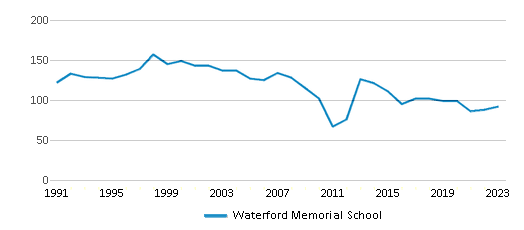
Gender %
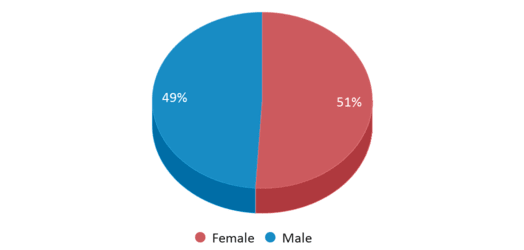
Total Classroom Teachers
9 teachers
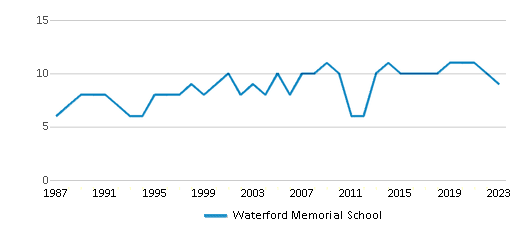
Students by Grade
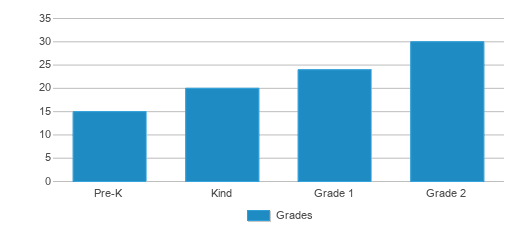
School Rankings
The diversity score of Waterford Memorial School is 0.15, which is less than the diversity score at state average of 0.26. The school's diversity has stayed relatively flat over five school years.
Math Test Scores (% Proficient)
(11-12)40-59%
61%
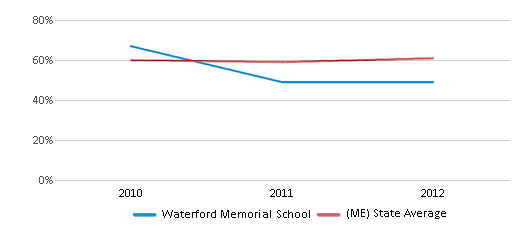
Reading/Language Arts Test Scores (% Proficient)
(11-12)60-79%
69%

Student : Teacher Ratio
10:1
11:1
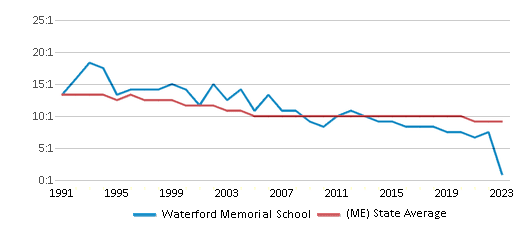
American Indian
n/a
1%
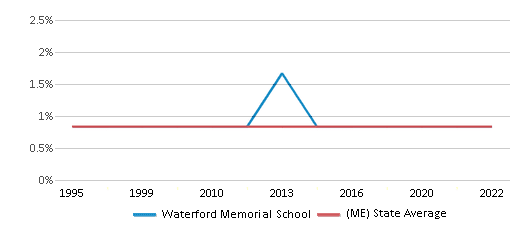
Asian
n/a
1%
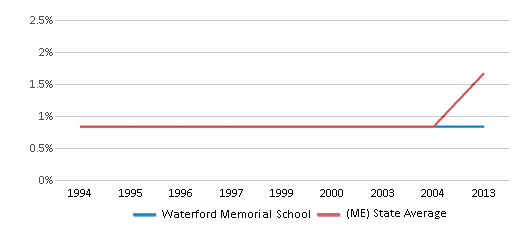
Hispanic
7%
3%
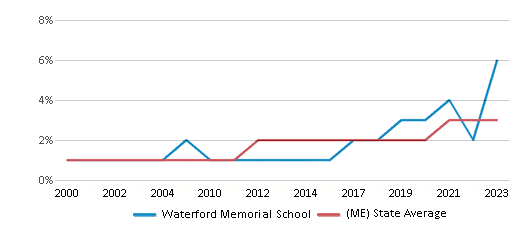
Black
n/a
5%
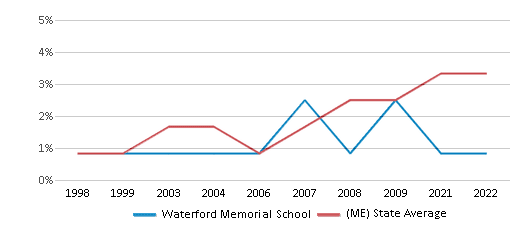
White
92%
86%
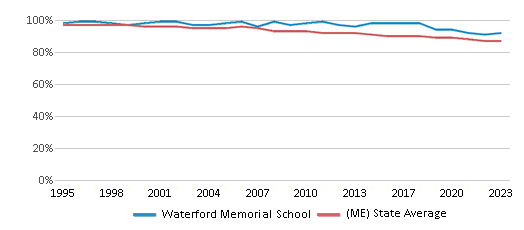
Hawaiian
n/a
n/a
Two or more races
1%
4%
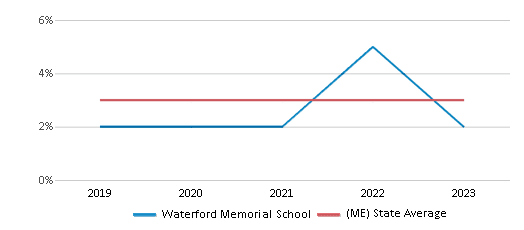
All Ethnic Groups
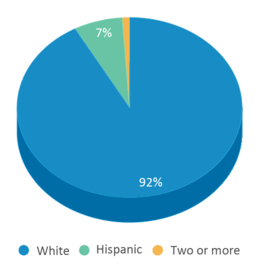
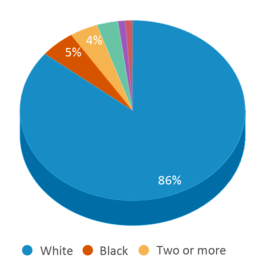
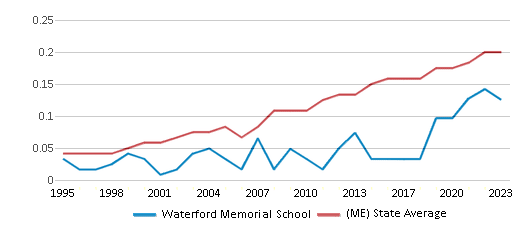
Participates in the National School Lunch Program (NSLP)
Yes
Eligible for Free Lunch
65%
33%
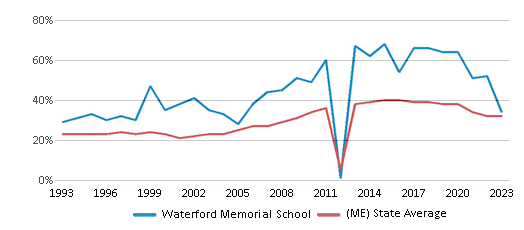
Eligible for Reduced Lunch
1%
6%
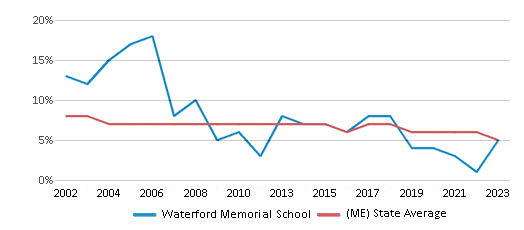
School Statewide Testing
School District Name
Source: National Center for Education Statistics (NCES), ME Dept. of Education
Frequently Asked Questions
What percent of students have achieved state testing proficiency in math and reading?
40-59% of students have achieved math proficiency (compared to the 61% ME state average), while 60-79% of students have achieved reading proficiency (compared to the 69% ME state average).
How many students attend Waterford Memorial School?
89 students attend Waterford Memorial School.
What is the racial composition of the student body?
92% of Waterford Memorial School students are White, 7% of students are Hispanic, and 1% of students are Two or more races.
What is the student:teacher ratio of Waterford Memorial School?
Waterford Memorial School has a student ration of 10:1, which is lower than the Maine state average of 11:1.
What grades does Waterford Memorial School offer ?
Waterford Memorial School offers enrollment in grades Prekindergarten-2
What school district is Waterford Memorial School part of?
Waterford Memorial School is part of RSU 17/MSAD 17 School District.
School Reviews
5 9/8/2008
I believe the outstanding and dedicated staff is to be commended for their knowledge & application of grade level curriculum and the devotion of on to seeing that their students are exposed to material in such creative ways that are ale to easily, as well as meaningful, daily life connections and vice versa. I have received ideas and helpful information from primary teachers employed by Waterford Memorial Elementary School over the years. I have also been grateful for ideas, especially in my earlier years as a new teacher in a major city refreshing nature activities were welcomed. Thank
Review Waterford Memorial School. Reviews should be a few sentences in length. Please include any comments on:
- Quality of academic programs, teachers, and facilities
- Availability of music, art, sports and other extracurricular activities
Recent Articles

What Is A Charter School?
Explore the world of charter schools in this comprehensive guide. Learn about their history, how they operate, and the pros and cons of this educational innovation. Discover key facts about charter schools, including admission policies, demographics, and funding, as well as what to look for when considering a charter school for your child.

10 Reasons Why High School Sports Benefit Students
Discover the 10 compelling reasons why high school sports are beneficial for students. This comprehensive article explores how athletics enhance academic performance, foster personal growth, and develop crucial life skills. From improved fitness and time management to leadership development and community representation, learn why participating in high school sports can be a game-changer for students' overall success and well-being.

February 05, 2025
Understanding the U.S. Department of Education: Structure, Impact, and EvolutionWe explore how the Department of Education shapes American education, from its cabinet-level leadership to its impact on millions of students, written for general audiences seeking clarity on this vital institution.






